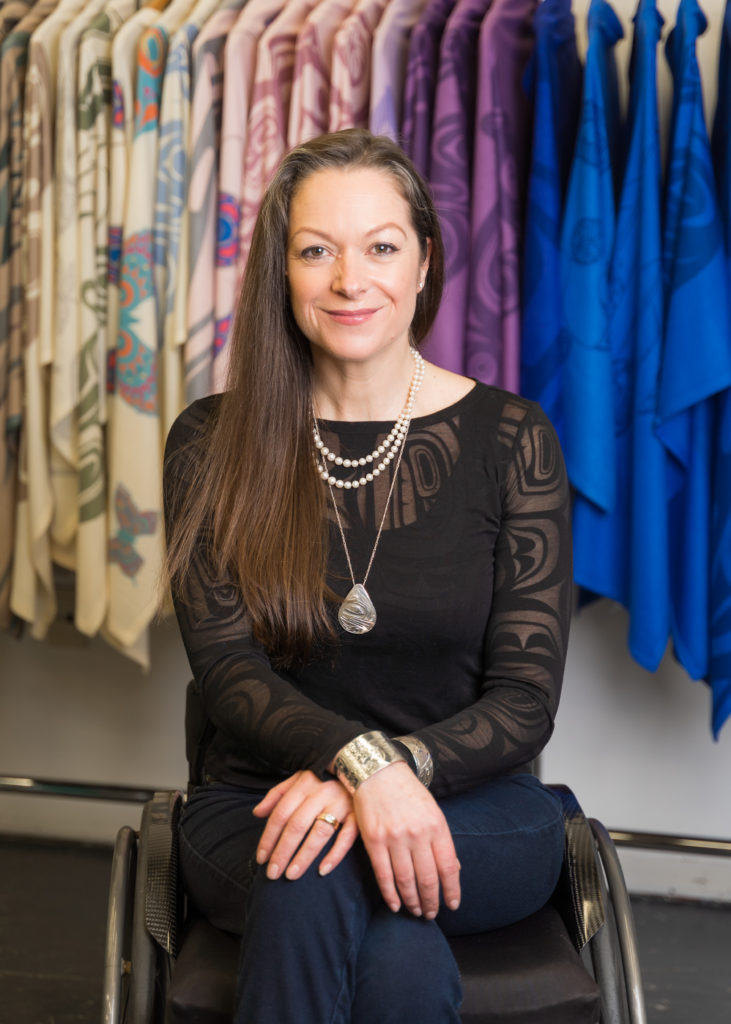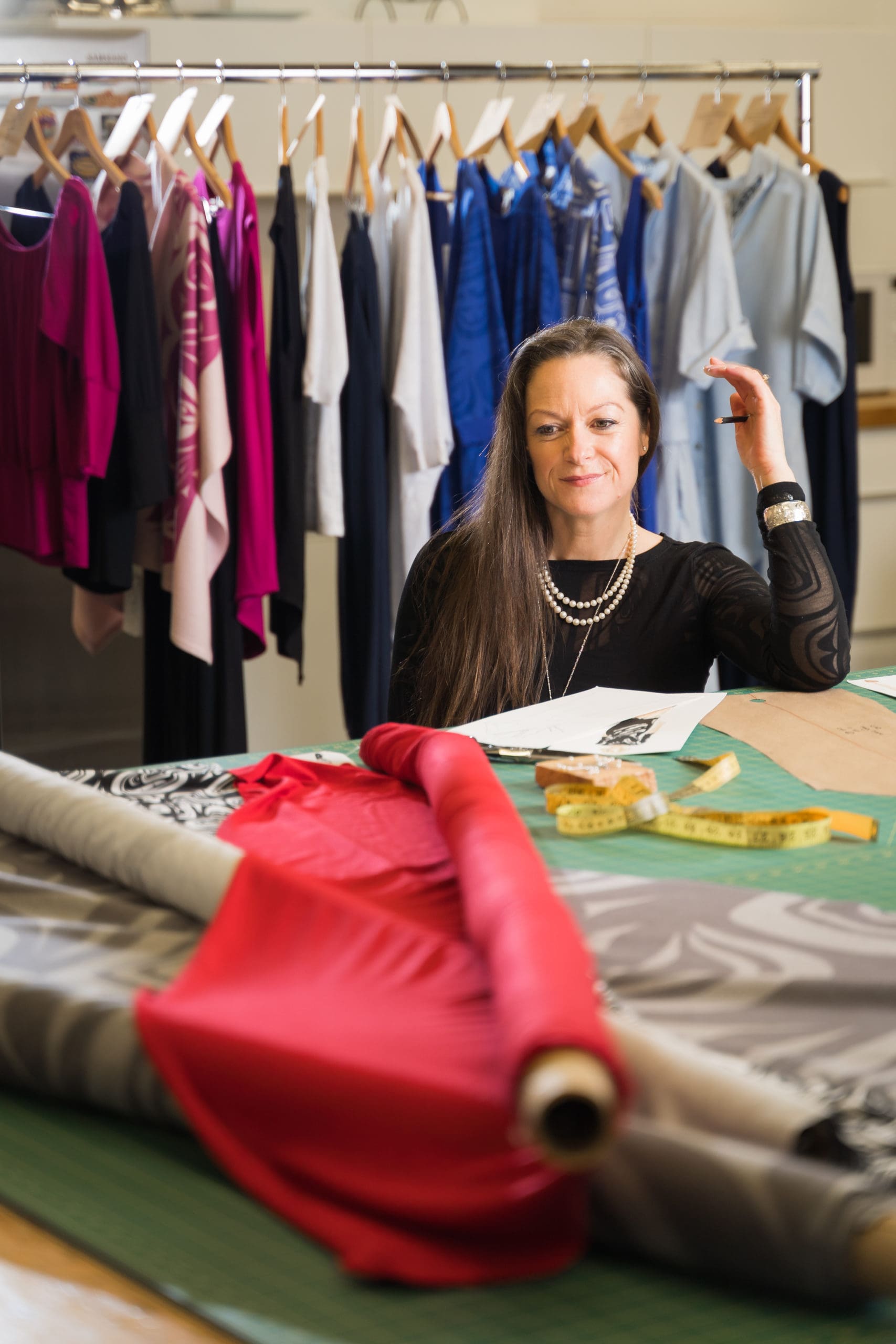Originally from the Sunshine Coast, Chloë Angus is the recipient of the 2022 Courage To Come Back Award in the medical category. Chloë has overcome great adversity and given back to her community through her advocacy work and support in developing an exoskeleton for spinal cord injury (SCI) survivors with Simon Fraser University. She’s a tireless advocate for people living with SCI through speaking engagements, volunteering and mentoring for SCI organizations and charities across the world, and is also founder of her own fashion line, Chloë Angus Design; she released her spring 2016 collection while in the hospital! We chatted with this incredible and inspiring woman to learn more. —Noa Nichol

Please tell us a bit about yourself to start, as well as about the moment your life changed forever.
My name is Chloë Angus. I am a fashion designer and exoskeleton activist. In 2015, I achieved the life I had always dreamt of. I walked runways and red carpets. I met movie stars and media personalities, politicians and princesses. I drank bubbly for breakfast—and wore ball gowns to picnics. My life changed dramatically when I suffered a spinal cord injury in June 2015 due to a rare benign tumor in my spinal cord. Twenty-four hours after driving myself to the hospital with a sore back and numbness in my toes doctors told me I would never walk again. They told me I would learn to live my life in a wheelchair. I literally went from “running” a fashion design company to not being able to get out of a chair!
When you were diagnosed with spinal cord injury (SCI), doctors told you there was no treatment or surgery and tht high doses of opioids, drugs and antidepressants would be required to function. Why did you refuse to accept this as the only solution, and what were some alternative treatments you’ve used or continue to use to manage your condition?
I did not want to live the rest of my life dependent on drugs, even if they were prescribed by a doctor. It was obvious to me that drugs are not a long-term solution, so I learned to manage my painful condition with alternative treatments including massage, acupuncture, CBD, nutrition, exercise, mindfulness, and ongoing physiotherapy including exoskeletons, gait training over a treadmill, and aqua therapy.
You have done so much advocacy work, including providing support in developing an exoskeleton for SCI survivors with Simon Fraser University. Can you please give us an overview of this work, and tell us why it’s so important to you to be involved in it?
After my spinal cord injury, I was on a mission to recover to my fullest ability and to continue on going rehabilitation to help manage the secondary health complications of living with a motion disability. I first learned about exoskeleton technology after discovering an article in popular science magazine online when I was still in the hospital. Doctors told me I would never walk again but when I read about this new technology that was going to help paralyzed people walk, I felt hopeful at the possibility. It took considerable effort to access using an exoskeleton but after much advocating for myself I got to try my first exoskeleton in a rehab center. I clearly remember the feeling of putting on an exoskeleton for the first time, standing up and walking across the gym floor, after I was told I would never walk again. It felt amazing! And it opened my eyes to the possibilities of this new technology. Although it felt amazing to be walking again, the exoskeleton was not easy to use and required two attendants to assist me in using it. The device could stand me up, but it had no balancing capabilities and I had to use a walker or arm crutches to keep from falling, which took considerable arm strength and hand function, and bravery on my part. It also lacked range of motion, only allowing me to walk forward in a robotic and unnatural way. If I needed to turn in the device an attendant would have to grab me by the shoulders and physically turn my body. It was physically and mentally exhausting for me to use and took considerable time and effort on the part of the physiotherapy assistants. I knew then that exoskeleton technology was the future of mobility, but it needed to be improved to truly impact the lives of those who need it. It was at that time that I searched the world for anyone working on exoskeleton technology, I was amazed to find a brilliant team right in my own backyard! That is when I met the founders of Human In Motion Robotics and joined the team to help advance this much needed technology, addressing the issues from a person with lived experience and end user’s perspective. Human In Motion Robotics (HMR) has developed what I believe to be the most advanced exoskeleton on the planet. After six years of dedicated development, I can say with complete confidence that our exoskeleton is a radical improvement to the current technology and is the future of all human mobility. I now have an exoskeleton that I can use independently (no assistant, no arm crutches!), that is self-balancing, articulate, fast, smart, and provides me with the mental and physical health I need to live a full, happy, productive life. HMR is built by a diverse team with experience in physiotherapy, occupational therapy, and most importantly people with lived experience, to ensure the device’s realistic application and successful market adoption. Our vision is to build advanced exoskeletons for daily personal use, I can’t wait for the day when we see people with motion disabilities walking down the street in our exoskeleton instead of being limited to living in a wheelchair. Canada is known for building the robotic space arm and now we will be known for building robotic legs, too! HMR is currently opened for investment opportunities.
You are also a tireless advocate for people living with SCI; what motivates, inspires and keeps you going?
My world became very limited and after learning about the ongoing secondary health, complications associated with living in a wheelchair I set out to improve the situation for myself and others. My personal experience of navigating the medical system through my spinal cord injury journey was, and is still, very difficult. I believe we can, and must do better, and that by working together we can improve SCI care in Canada.
Why do you believe that better care and access to ongoing physical rehabilitation including exoskeletons should be available to all?
The secondary health complications of living with a motion disability are devastating and progressive; muscle atrophy, pressure sores, complications with bowel and bladder, circulation, bone density loss, and extreme nerve pain are the physical results but there are huge emotional challenges as well. This is why having access to ongoing physical rehabilitation is incredibly important, by simply keeping people moving we can ward off these secondary health complications and provide people living with motion disabilities with a better quality of life. When I use my exoskeleton, it changes everything for me, the positive effects of being up right and moving are what drives me to push for better care and access to advanced technologies that can dramatically improve the lives of millions of people.
You’re also a designer, with your own incredible clothing line! When and why did you launch Chloë Angus Designs, and what makes your collections unique?
I was born to do fashion, even growing up on a remote farm could not keep me from dreaming up dresses. It is where I grew up that impacted my design esthetic and what makes my collections unique. I had the privilege of living within a predominantly First Nations’ community on the Sunshine coast of B.C. This gave me an understanding and a deep respect for their knowledge, strength and culture. When I launched my company, I wanted to focus on sharing that positive experience through a collaborative fashion collection. The Spirit Collection is my way of honouring the Indigenous People of Canada. Collaborating with Indigenous artists to create a modern representation of Canadian style for women, men, and home. Collaboration is the core value at Chloë Angus Design, together with artists of diverse backgrounds from Canada and around the world, we believe that collaboration between Indigenous and non-Indigenous peoples creates a collection we can all celebrate.
Congratulations on being named the recipient of the 2022 Courage To Come Back Award in the Medical category! What does this mean to you?
Thank you so much! My name might be on this award but there are so many people that have helped me along the way that I wish everyone’s name could be on it. It is great recognition of what can be accomplished when we work together.

Be the first to comment